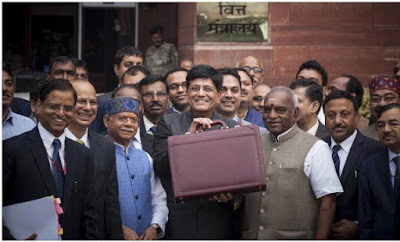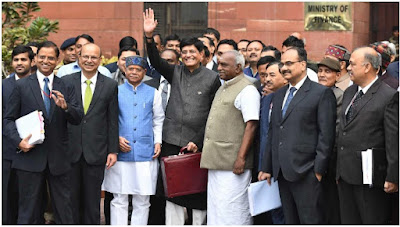budget highlights, interim budget, budget planner, financial budget, union budget live, budget, budget highlights, budget live, budget list
Interim Budget 2019 Highlights
First of all, the budget section of the revenue discipline. The fiscal deficit (FISCAL) deficit was 3.3 per cent of GDP. But in the revised budget it will rise to 3.4 per cent. For the last three years, the fiscal deficit has exceeded the target. The increase in fiscal deficit means that the interest burden will increase further in the next year. It is also seen in the current year that around 40 per cent of the central government's tax revenues is being spent only to meet interest. As a result, the absence of the fiscal deficit means the failure to achieve revenue discipline - failure to achieve revenue discipline. Revenue (Revenue) deficit can stand at 2.5 per cent this year. This is the highest after the first year of the Modi government.
The fiscal deficit remained unchanged at 3.4 per cent of the GDP in the fiscal year 2019-20. That means that in the coming year there will be no shortage of fiscal deficit reduction. As a result, it is also a matter of great concern for revenue discipline. After the inspection, more people have filed tax returns. However, the effectiveness of the tax-GDP ratio is not very slow. In the 2015-16 fiscal year, where the ratio was 10.6, it could stand at 11.1 per cent in the current fiscal year. The direct tax-GDP ratio is 5.5% in fiscal year 5.5, which is 5.9 in the current fiscal year. It is clear here that many more people submit income tax return but the tax revenues are increasing very little. As a result, it is also a matter of concern for revenue discipline. That is, the yield of demonetisation is little.
Current account deficit (CAD) is said to be 2.5 per cent of GDP next year. It's much more than the last four years. This year it can be increased to 3 per cent. It is also a matter of concern in foreign trade.
Since the emigration, the private investment, in particular, has dropped drastically. In the last four years, the percentage of total fixed capital formation is 28.5 per cent of GDP. It was around 34-35 per cent during the UPA regime. As a result, the main objective of employment is now government investment. But in the last four years, government investment in terms of GDP has decreased gradually. It is also seen in the budget presented today - in 2018-19 it has decreased further. In the coming financial year, there is a hint of further reduction. In the coming financial year, the total expenditure of the government's expenditure on the total expenditure of 27.84 billion crores has been estimated to be only 3,36,000 crores. It's just 12 per cent of the total cost. It is easy to guess why the unemployment rate in the last ten years of Modi government is maximum?
In this budget, the Modi government has tried to bring more benefits to every level of society. In the two projects, Prime Minister Kisan Samman Nidhi and Labor Yogi Makanda, Modi tried to relieve some 22 million family wounds a bit. In the Prime Minister Kisan Mela Nidhi project, small and marginal farmers (landowners up to 2 hectares) have been announced to pay a total of 6000 Rupees in three instalments for each year. It is said that 1.2 crore small and marginal farmers will be benefited. As a result, the annual cost will be Rs. 75 thousand crores. In the current financial year, a one instalment payment will be given from December last. This will cost additional Rs.20 billion in the current year. The second project is the pension scheme for unorganized workers. Announcing the payment of Rs.3,000 per month to 60 million unorganized workers, up to 60 years. However, when it is operational, it will be submitted to the project Rs. 100 per month.
It has been said that the farmers will be given a discount of 2 per cent interest on the loan amount. If you pay the loan on time, the discount will be 1 per cent more. In addition, if the crop is harmed by natural causes, the discount will be more than 2 per cent more. In the case of fisheries and livestock loans, interest will be 2 per cent discount. 1% discount for payment on time. In the small and medium-sized industries, the interest on loans up to Rs.1 crore will be 2 per cent.
There has also been a considerable concession for employer taxpayers. The Modi government did the initial rebate to the income tax of 2 to 2.5 lakhs. Now the income is up to 2.5 to 5 lakh rupees! Apart from the standard deduction, the amount is Rs.50 thousand, Rs. 50 thousand. The limit of interest on the storage of bank and post office is increased from Rs.10 thousand to Rs.40 thousand. Till the payment of Rs. 1 lakh 80 thousand from the house rent did not have to pay so much, now this limit was increased to Rupees.
More than 8 lakh free cooking gas connections have been announced. The expenditure on flagship programs or Central sponsored schemes is only 7.5 per cent-3 lakh to 4 thousand crore to 3 lakh 27 thousand crores. The project cost of 100 days work did not increase substantially - in the current year, the allocation was 55 thousand crore, additional 6 thousand crore rupees were given in the current year. But this amount has been categorized for the next year only Rs. 60 thousand crores. However, the Prime Minister said the allocation for rural road planning has increased - 80 per cent. Expenditure increased by 18 per cent in the National Education Commission, 17 per cent in ICDS, 35 per cent for Scheduled Castes and Scheduled Tribes, and 28 per cent for Scheduled Tribes.
Overall, this budget is undoubtedly a public opinion. Looking at the upcoming vote, it is difficult to guess that this budget has been created. However, the problem is that shrewd The revenue growth is not in effect in this budget. The indirect tax is likely to not exceed 11 per cent of GST revenue. In the money box









0 Comments